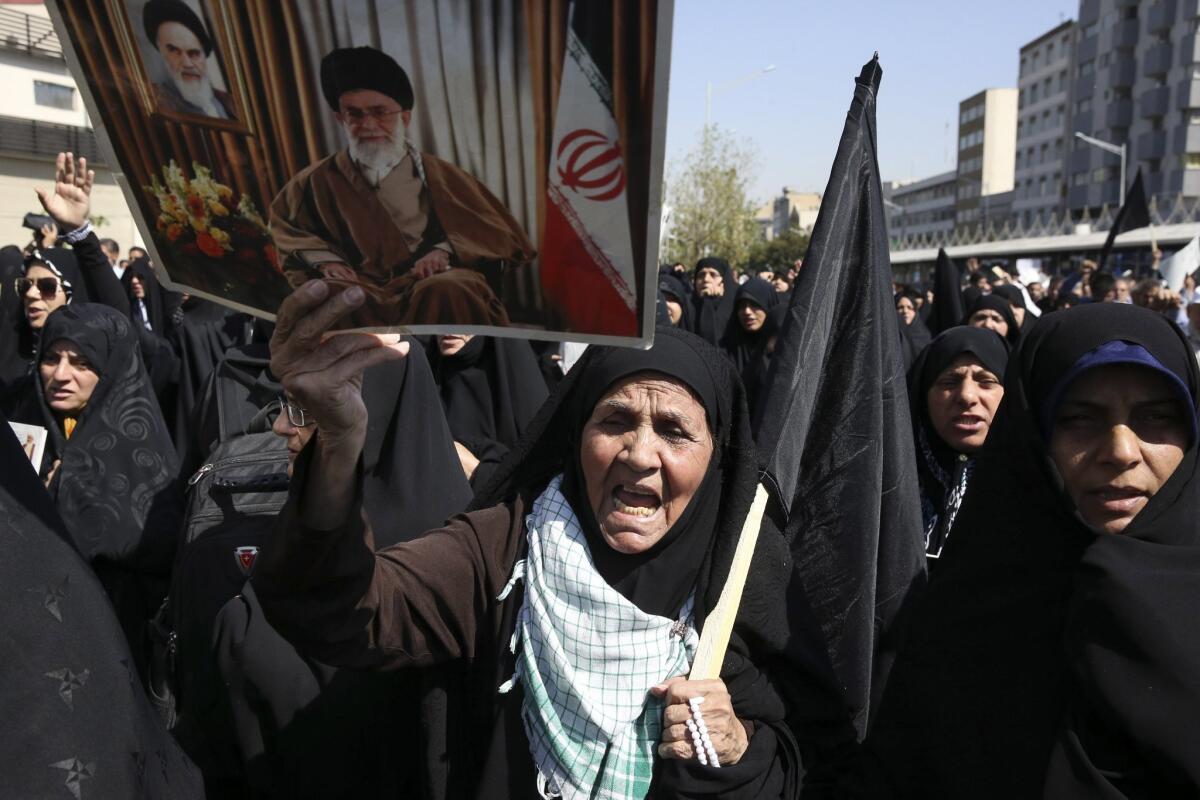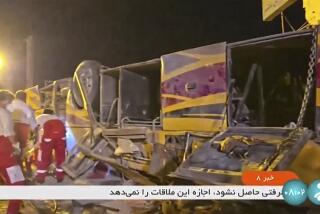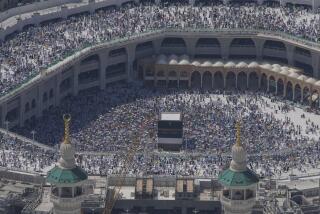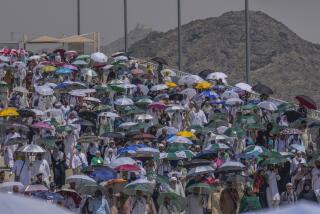Iranians denounce Saudis’ stewardship of hajj after latest disaster

An Iranian woman holds a poster of Supreme Leader Ayatollah Ali Khamenei and late revolutionary founder Ayatollah Khomeini at an anti-Saudi rally in Tehran on Sept. 25.
Reporting from Tehran — An outpouring of grief for the dead and indignation against Saudi Arabia’s leadership swept across Iran on Friday, a day after more than 700 pilgrims were killed and more than 800 injured in a crush outside the Muslim holy city of Mecca.
The casualties included at least 131 dead Iranians and 85 injured among those making the hajj pilgrimage to Islam’s holiest sites, Iranian authorities said.
The catastrophe immediately served to exacerbate tensions between Tehran and Riyadh, geopolitical rivals for influence in the Middle East and among regional Muslims.
Iran’s supreme leader, Ayatollah Ali Khamenei, declared three days of national mourning and called on Riyadh’s ruling monarchy to “shoulder its heavy responsibility” for the tragedy and “meet its obligations in compliance with the rule of righteousness and fairness.”
Others were more harsh in their condemnation, charging that Saudi incompetence and mismanagement had led directly to the latest pilgrimage calamity, which occurred during Eid-al-Adha, Islam’s major feast.
“We can by no means remain indifferent toward Saudi Arabia’s irresponsible behavior,” said Hossein Amir-Abdollahian, Iran’s deputy foreign minister, according to the official Press TV outlet.
Friday prayer sermons in Iran were filled with censure of Saudi officials, while on social media, images circulated showing bodies of men in white hajj garments piled in rows and rescue workers attempting to revive victims.
Adding to the outrage of many here were official Saudi suggestions that the pilgrims’ failure to heed crowd-control regulations contributed to the tragedy. Critics said the Saudis were blaming the victims in a cowardly bid to evade accountability.
NEWSLETTER: Get the day’s top headlines from Times Editor Davan Maharaj >>
“They say it was too hot, that there was panic, but they [Saudi officials] should take responsibility,” declared Mahmoud Emami Kashani, prayer leader in Tehran, who called for criminal charges to be filed against responsible Saudi officials. “It is absurd that Saudi Arabia is saying there was panic and anarchy.”
The prayer leader and others called for stripping Saudi Arabia of its role as overseer of the annual hajj — an extremely unlikely prospect because Riyadh’s ruling Al Saud dynasty prides itself as the custodian of Islam’s holiest shrines in the Saudi cities of Mecca and Medina.
“I do not think we can manage to remove Saudi Arabia from its role in the hajj, but we can shout our protests anyway,” said Hassan Shaikhi, 70, who was entering the subway in Tehran after attending an anti-Saudi demonstration in the Iranian capital.
In Iran and elsewhere, the calamity raised anew questions about whether the oil-rich kingdom has adequate infrastructure and safeguards to handle an event that is considered the world’s largest yearly gathering of humanity. Organizing the hajj is a massive logistical challenge.
Aside from its religious significance, the hajj is also a major generator of income, reportedly second only to oil revenues for Saudi Arabia.
At least 717 pilgrims from across the globe were killed and at least 863 others injured in Thursday’s incident, according to news agency accounts. Authorities were in the process of identifying the victims and determining their nationalities.
Thursday’s incident was the deadliest at the pilgrimage since more than 1,400 people were trampled in a tunnel near Mecca in 1990.
Saudi King Salman offered condolences to the victims and pledged a review of hajj procedures, while asserting that the pilgrimage would go on. Saudi authorities vowed a rapid investigation to determine what went wrong.
See the most-read stories this hour >>
A Saudi interior ministry spokesman, Maj. Gen. Mansour al-Turki, suggested publicly that the crush may have occurred when groups failed to adhere to their scheduled movement times. Authorities attempt to impose a strict regulation on the progress of the assembled multitudes.
In excess of 2 million pilgrims from more than 170 nations descended upon Saudi Arabia for this year’s pilgrimage, officials said. More than 100,000 security personnel and 25,000 health workers were assigned to the event, the Saudi government said.
According to reports, the crush occurred as large groups of pilgrims in Mina, east of Mecca, were on their way to perform the “stoning of the devil” ritual at a place called Jamarat.
During the ritual, the faithful toss pebbles at walls representing Satan, symbolically reenacting the stoning of the devil by Abraham, regarded as a prophet. In 2006, more than 300 pilgrims were killed in a crush at Jamarat.
According to a statement from the Saudi civil defense directorate, Thursday saw a “sudden” increase in the number of pilgrims converging on Jamarat, leading to “crowding and pushing.” The Saudi health minister, Khaled al-Falih, told a local television station that the pilgrims had ignored instructions and timetables meant to avert a bottleneck at the site.
The Saudi government has said that security and logistical improvements in recent years have made the pilgrimage a much safer experience. But many in Iran charged that the latest series of tragedies suggested otherwise.
Two weeks ago, a crane tumbled onto the grounds of Mecca’s Grand Mosque during a storm, killing more than 100 people, including several dozen Iranians, according to media accounts in Iran.
The pilgrimage is designated as one of the five pillars of Islam. All Muslims who are physically able are expected to perform the hajj at least once in their lives, according to doctrine.
Special correspondent Mostaghim reported from Tehran and Times staff writer McDonnell from Beirut. Special correspondent Nabih Bulos in Beirut contributed to this report.
Follow @mcdneville on Twitter for news out of the Middle East
ALSO:
Hajj disaster: Are large crowds inherently dangerous?
Saudi official blames high wind for Mecca crane collapse
Stoning the devil and other highlights of a Fullerton pilgrim’s hajj, the journey of a lifetime
More to Read
Sign up for Essential California
The most important California stories and recommendations in your inbox every morning.
You may occasionally receive promotional content from the Los Angeles Times.










